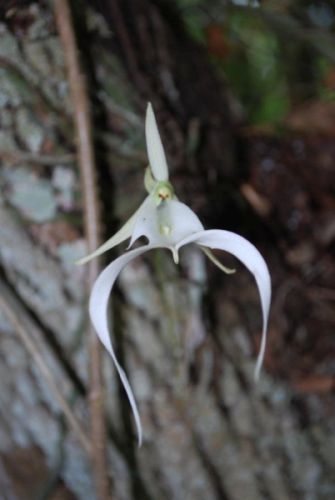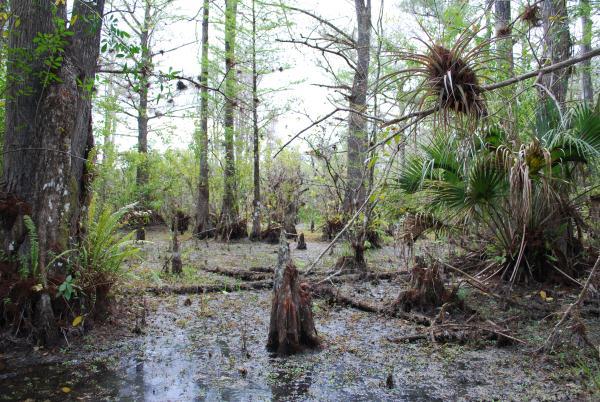
The Big Cypress National Preserve is a United States National Preserve located in southern Florida, about 45 miles (72 kilometers) west of Miami. The 720,000-acre (2,900 km2) Big Cypress, along with Big Thicket National Preserve in Texas, became the first national preserves in the United States National Park System when they were established on 11 October 1974 Big Cypress borders the wet freshwater prairies of Everglades National Park to the south, and other state and federally protected cypress country in the west, with water from the Big Cypress flowing south and west into the coastal Ten Thousand Islands region of Everglades National Park. When Everglades National Park was established in 1947, Big Cypress was originally intended to be included; however, because the land had not been purchased from its private owners, Big Cypress was ultimately released from the park system. The preserve is the most biologically diverse region of the terrestrial Everglades, and while dominated by a wet cypress forest is host to an array of flora and fauna, including mangroves, orchids, alligators, venomous snakes like the cottonmouth (Agkistrodon piscivorus conanti) and eastern diamondback rattlesnake (Crotalus adamanteus), a variety of birds, and the Florida panther, (Puma concolor couguar) and the Florida Black Bear. The preserve is also home to nine federally listed endangered species including the West Indian Manatee, the eastern indigo snake (Drymarchon corais couperi), and the Florida Sandhill Crane (Grus canadensis pratensis). There are few "big cypress" in Big Cypress National Preserve. The name comes from the great expanse of cypress forest, hundreds of thousands of acres, within the Big Cypress Swamp.
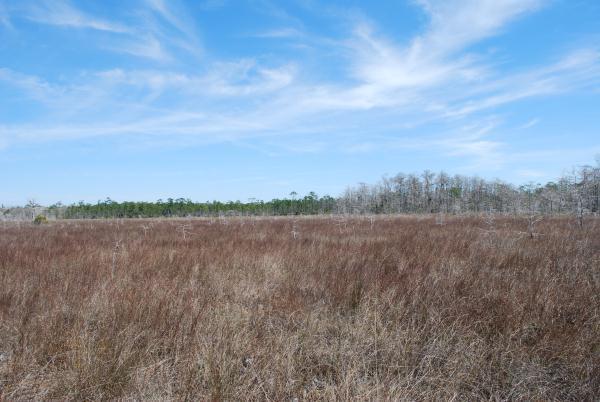
This huge swamp or wetland acts like a filter, straining out impurities and pollutants as the water flows over it making the water cleaner downstream and as it percolates into the aquifers. It also acts like a sponge, absorbing the water as it flows. Without this sponge effect the water would run off the land quickly and flood some areas. Most of the water we all use for our daily things comes from the Shallow Aquifer of Southwest Florida which lies deep beneath at the Big Cypress Swamp.
The Preserve gets its water mostly through rainfall, but also from the wetlands to the North and West. The water flows through the Preserve southward through the eastern portion of Everglades National Park. Along its journey it passes through many habitats that are used by wildlife and people in many ways. As in many parts of South FL the Big Cypress also has two main seasons wet and dry that drastically affect the water levels in many areas of the preserve, most of the ground in many of the habitats is mainly compose of sand, silt, clay, Miami Oolite and organic material. Solution holes which are made from Miami Oolite formations help hold most of the water in the swamp areas and determine the ground elevations on most of the dry areas such as Pinelands and Hardwood Hammocks.
Water is the most important geological/environmental feature of Big Cypress National Preserve and because of that the Preserve was created. There are many factors that determine what organisms live in and around the water. One of these factors is water depth. Many aquatic species of plants and animals depend on the depth of the water to survive. The water depth varies throughout the Preserve depending on the amount of rain that falls and the elevation of certain areas. This causes some areas to have longer or shorter hydroperiods and determines what plants and animals are able to survive there. The deepest water is found in the Cypress Domes. Even during the dry season the centers of the cypress domes stay wet and provide habitat for the alligators. This is why they are often called alligator holes. The pinelands are often the driest areas resulting in species of plants that require less water such as saw palmetto, sabal palms and pines.
Another factor is water temperature. Water temperature is often affected by water depth and air temperature and can also determine the species found in various habitats.
Dissolved Oxygen is the oxygen within the water. This oxygen is essential to aquatic animals and some plant species. Aquatic animals respire or “breathe” oxygen from the water and most animals require a certain amount of oxygen to be in the water. Low levels of dissolved oxygen results in lower diversity of life. Some plant species use oxygen from the water instead of the air to carry out photosynthesis.
pH is a measure of the acidity or alkalinity in the water which also determines what lives there. It can be affected by chemical reactions in the water such as decaying organic matter and dissolving bedrock.
Water colors change throughout the habitats. Tannins from the pine needles and other vegetation turn the water brown like tea. Algae can cause it to turn green. Water color can also be affected by the amount of suspended sediments within the water, like pollen, which can appear yellow.
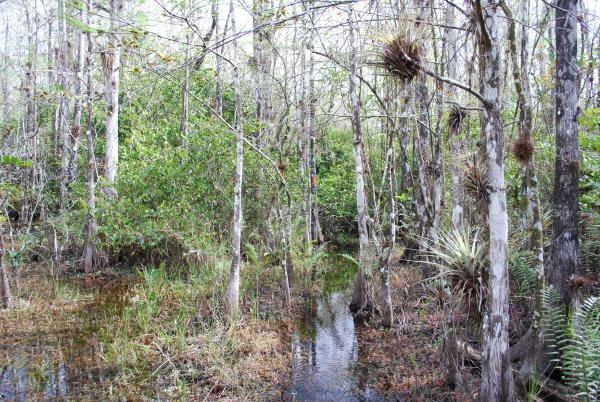
Soil is formed from particles of rock that are broken into smaller pieces by physical, chemical and biological weathering processes mixed with dead plant and animal matter. The formation of soils is affected by climate, topography, living things, rock composition and time. Soil is made up of sand, silt, clay, Miami Oolite and organic material.
Soil moisture is a critical characteristic and dictates what types of plants will grow in an area and it determines if an area will flood or the water will run off. About one fourth of the volume of productive soil is water as either a vapor or a liquid.
Soil temperature influences all living organisms. The upper layers of soil insulate the deeper layers of soil and their inhabitants from temperature extremes.
Soil color is determined by the amount of organic matter present and on what minerals it contains, such as calcium carbonate that colors the soil white if the area is dry.
Texture is determined by the amount of clay, silt and sand in the soil. Sand is the largest particle, silt is next in size and clay is the smallest and defined as being smaller than 0.002 mm. Gases may be trapped in anaerobic soils. Plants are broken down by little organisms powered by anaerobic respiration which gives off alcohol and methane gas. When you are walking through the swamp the methane gas is released and you can sometimes see the little bubbles of methane coming up to the surface, leaving a sheen on the water. The Methane gas smells a little like rotten eggs. Sulfur also hangs around in soils that are wet most of the time and is sometimes present as a residual from oil and gas. It also has a very strong odor of rotten eggs. The three main soil types in the Big Cypress are organic, marl, and sand.
Organic soils form when litter builds up. In dry areas the organic material is destroyed by fire, decay and oxidation. If water covers an area so that oxygen for decay is lacking, plant bits build up as peat. Peat development is dependent on water depth, pH, hydroperiod, vegetation type and topography.
Peats and mucks, both having organic materials, have a greater ability to store water and serve as a reservoir for nutrients.
Carbonate marls are the most widespread loose soil type. These may occur as thin sheets over prairies, or more thickly in lakes and sloughs. Marl is a crumbly soil consisting mainly of clay, sand and calcium carbonate.
Sand is a loose granular material, made up primarily of quartz or calcium carbonate, that results from the disintegration of rocks. It contains particles that are smaller than gravel but coarser than silt.
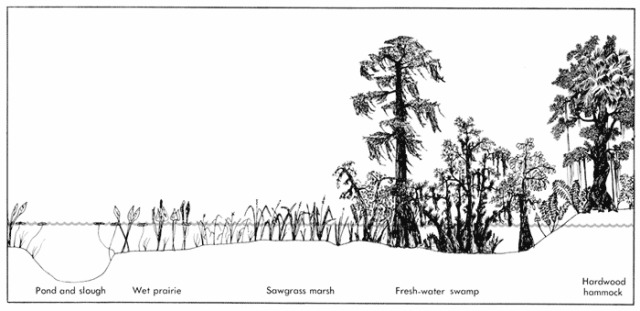
Ecologically, the preserve is slightly more elevated than the western Everglades, and Big Cypress has historically served as home to Native Americans, including the Miccosukee and Seminole tribes, as well as early settlers who hunted herons and egrets to supply feathers to hat-makers in New York and Paris, and poachers who hunted American Alligators and Crocodiles to near extinction. The timber industry also operated in the area, and built railroads to haul out most of the cypress ecosystem's old growth trees. Portions of the Big Cypress were also farmed for winter vegetables.
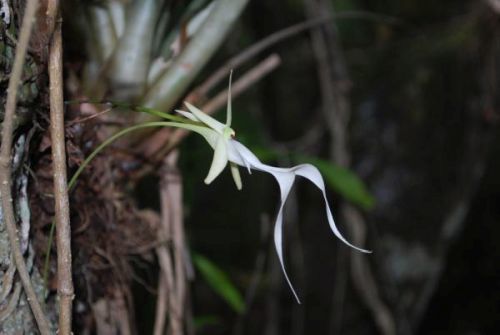
Habitats in Big Cypress National Preserve
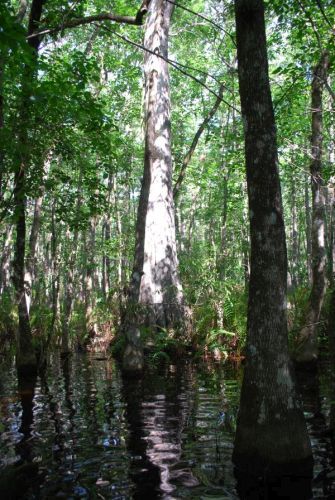
The five basic habitats of Big Cypress National Preserve include hardwood hammocks, pinelands, prairies, cypress swamps, and mangrove forests. Each is unique in the type of plants, soils and animals it contains depending on the elevation, which can range from sea level to 17 feet. During the field trip to the preserve you will be exploring at least three of these habitats.
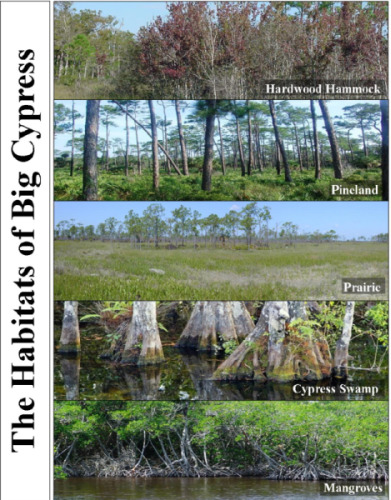
Hardwood Hammocks are found on slightly elevated bedrock areas or on the remains of Calusa shell mounds. Hammocks look a bit like a tropical forest due to the rich diversity of ferns, epiphytes, lichens and vines that grow in their sheltered interior. Oaks, wild tamarind, cabbage palms, maple and saw palmetto are often found in these tree islands. Hammocks have a hydroperiod of about 10-45 days. The plants in the hammock provide food and shelter to many different organisms including the Florida panther which likes to lounge in the tall trees during the day. The Ligguus Tree Snail can also be found in many hammocks.
Pinelands come in two types, one with an understory made up mostly of saw palmetto and the other with a mixed grass understory. South Florida Slash Pine is the dominant overstory species. This slash pine has developed longer taproots and smaller needle size than its northern cousin. These adaptations allow the South Florida Slash Pine to survive the spring droughts and summer floods. This pine is also very tolerant of fire. Its seeds may be eaten by many types of rodents, insects and birds.
The slash pine is a very hard wood, extremely resistant to termites. This has made it a very desirable wood for building houses resulting in the logging of the old growth trees in Florida. The term Slash comes from the once widespread practice of extracting its sap by cutting diagonal slash marks in the trunk, draining the sap from the cuts and using it to make turpentine and other products.
A pine forest has a hydroperiod of about 20 – 60 days annually.
Prairies are called wet or dry based more on what plant species grow there than on the actual amount of water present. Wet prairies occur on mineral soils that are covered with water about 50-150 days per year. The water rarely gets any deeper than about 20 cm even in the wettest of seasons. Wet prairies usually burn at least once during a five year period. Without fire, woody plants would push out the prairie plant species. This would in turn cause prairie mammals and birds to lose their habitat.
Periphyton is a common part of the vegetation in wet prairies and is an important link in the wet prairie food chain. Periphyton is made up of many species of blue-green and green algae. It may form a blanket over the prairie floor that is 4 cm thick or more. Periphyton is eaten by a variety of flies, snails, fish, tadpoles and zooplankton. During the rainy season, tadpoles and insect larvae hatch in prairies providing many wading birds, reptiles and amphibians with a good meal.
Cypress Swamps are magical places with most of the overstory made up of cypress trees. In the understory however, swamp fern, spikerush and marsh fleabane abound. Bladderwort, a carnivorous
plant that consumes many types of small water organisms including mosquito larvae, can often be found here. Buttonbush, cocoplum, willow and wax myrtle are among the woody understory plants you might find in the Big Cypress.
You may also see many bromeliads and orchids in a cypress swamp. These plants are called epiphytes. Epiphytes live on trees in the forest but cause no harm to trees. Some bromeliads get water and minerals directly from rain. Others funnel rain into a rosette of broad overlapping leaves. These “storage tanks” collect debris from the host plant, wind and insects, which in turn provides a rich nutrient liquid for the bromeliad. These bromeliads also provide a safe shelter to many small organisms such as frogs and insects. Whole food chains can be found on one plant. A few species of bromeliad, like the catopsis, have become insectivorous.
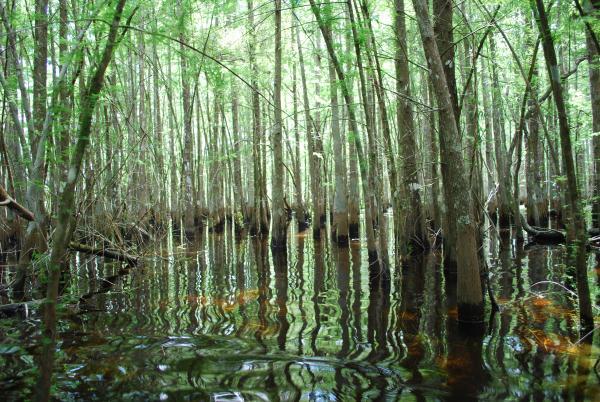
Squirrels, sandhill cranes and several species of ducks have been seen eating cypress seeds. Rabbits may eat branches, bark and roots of cypress seedlings. Cypress trees grow in water. The tallest trees grow in the deepest water where the collection of peat is greatest and the smallest trees occupy the edge. Cypress domes and strands have a long hydroperiod. The deeper areas stay wet throughout the year especially in the center of the domes and in the sloughs. On the perimeter of the domes and strands, and in sparsely populated areas of cypress, the water levels may drop considerably during the very driest time of the year, but the ground will usually remain moist and soggy.
Mangrove forests are another habitat found in Big Cypress. Mangroves are remarkable trees. They not only grow in the fresh water areas of the Preserve, but can also survive in the saltwater! There are three types of mangrove trees, red, black and white. The red will usually be found standing in water up to three feet deep and can keep salt from entering its root system. It can survive in water that has up to 35 p.p.m. (parts per million) which is the average amount of salt found in normal sea water. The Black and White Mangroves will allow some salt in and can extrude it or get rid of it through special cells in its leaves. The Black Mangrove is found in the saltiest environment, up to 100 p.p.m. This is the area where tides and storm surges reach, but then recede for a period of time. The water evaporates leaving high concentrations of salt in the soil. Mangroves add many benefits to the environment. Red Mangroves have strange, arching, exposed roots that help to trap and hold soil and debris, adding to existing land and keeping it from eroding with the waves and tides. This entangled root system also provides a safe haven for all kinds of tiny marine creatures including shrimp, crabs and small fish. Many types of fish that are caught and sold commercially, like grouper and snapper, spend a part of their lives hiding among the mangrove roots. Birds like egrets, herons and pelicans roost and nest in the mangrove trees. The mangrove leaves that die and fall into the water become covered with a slimy film that is broken down by decomposers. This detritus becomes food for all kinds of tiny organisms. They are eaten by larger organisms and so on right on up the food chain!
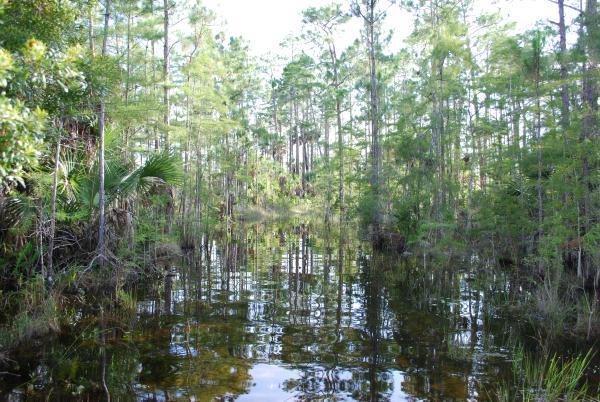
I hope you all enjoy this easy Earth Cache, I decided to place it in one of the most amazing areas of SFL which I hike almost every weekend and has shown me a great deal of its beauty as well its dangers, but not worry this cache is a the bright new visitor center so no need to bush whack, or swamp hike in order to get the smiley form this amazing place, you will do it all and see it from a comfortable 1* terrain, but I do invite you to explore the true Big Cypress don’t be shy and go get your feet wet in the hiking trails.
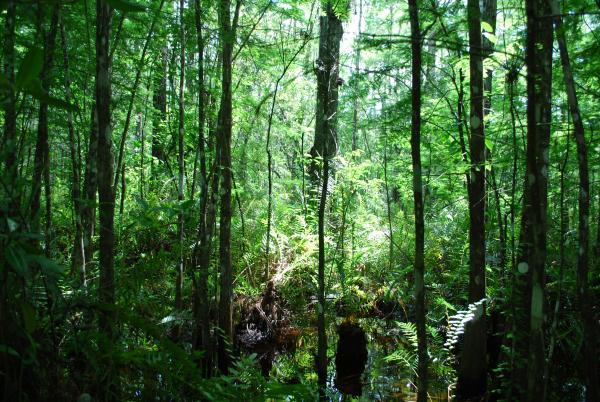
Here comes the fun part, in order to claim this Earth Cache you need to answer these few simple questions about this magical place
1.- In what year did the Big Cypress became a National Preserve?
2.- Where do you find The deepest waters in the Big Cypress?
3.- What is the Big Cypress soil mainly compose of?
4.- Name at least one of the two main functions for the solution holes
5.-Where does the name “BIG CYPRESS” comes from?
6.- Name the five habitats of the Big Cypress National Preserve
7.- Name the three main soil types in the Big Cypress
8.-Tell me what are the three "fake" animals that you will see along the trail?
9.- Take a walk along the boardwalk and tell me what kind of mangrove trees you see along the canal?
10.- Take a photo of you or your group at the end of the boardwalk with your GPS or PHONE (Optional)
